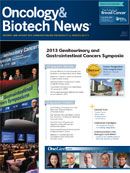Publication
Article
Oncology & Biotech News
Selumetinib May Reverse Resistance to Radioiodine in Patients with Advanced Thyroid Cancer
Author(s):
Patients with advanced thyroid cancer who develop resistance to treatment with radioiodine may benefit from the experimental drug selumetinib.
James A. Fagin, MD
Patients with advanced thyroid cancer who develop resistance to treatment with radioiodine may benefit from the experimental drug selumetinib, according to the results of a small proof-of-concept study recently published in The New England Journal of Medicine.
Radioiodine (iodine-131) is a standard postsurgery treatment that either ablates any thyroid tissue that is not removed via surgery or helps treat patients whose disease has spread to the lymph nodes or other parts of the body. However, patients with metastatic disease who become refractory to treatment with radioiodine tend to have a poorer prognosis.
Since other trials that have tested strategies for overcoming radioiodine resistance have not been successful in finding effective treatments for this particular group of patients, researchers led by James A. Fagin, MD, chief of Endocrinology Service at Memorial Sloan-Kettering Cancer Center in New York City, decided to investigate the use of selumetinib, a selective inhibitor of mitogen-activated protein kinase (MAPK or MEK) 1 and 2, for radioiodineresistant thyroid cancer. Previous research has shown that approximately 70% of papillary thyroid cancers have gene mutations that encode growth factor receptors such as RAS and BRAF. The activation of these proteins stimulates the MAPK pathway and subsequently inhibits the expression of genes responsible for thyroid hormone biosynthesis, including some involved with iodine uptake.
In this study, 20 patients with metastatic thyroid cancer whose tumors had become resistant to radioiodine received selumetinib (75 mg twice daily) after a 5-day lowiodine diet. Before and after 4 weeks of treatment with selumetinib, a thyrotropin alfa—stimulated iodine-124 PET scan was performed. Patients were administered radioiodine while receiving selumetinib if the second scan showed that it was possible to deliver 2000 cGy or more of iodine-131 to the cancer cells.
Selumetinib increased the uptake of iodine-124 in 12 of 20 patients, including four of nine patients with BRAF mutations and five of five patients with NRAS mutations. Of those 12 patients, eight reached the dosimetry threshold for radioiodine therapy. Of these eight patients, there were five confirmed partial responses and three patients had stable disease. The eight patients also had a decreased level of serum thyroglobulin, a protein in the blood used for thyroid cancer screening, with a mean reduction of 89%. No toxic effects ≥ grade 3 were observed as a result of administering selumetinib.
“Blocking this key pathway increased the uptake of iodine, making radioiodine treatment potentially effective once again,” Fagin said in a statement. “An advantage of this therapeutic strategy is that only a short course of drug therapy is required to elicit a significant clinical effect.”
A slight uptake in radioiodine in bone metastases was observed in patients who received selumetinib. The authors noted that bone metastases have been comparatively refractory to treatment with other kinase inhibitors.
While this particular strategy appears most effective in patients with RAS mutations, Fagin said “the hope is that a larger trial will shed light on whether selumetinib can be effective for a broader range of advanced thyroid cancer subtypes.” In the paper, Fagin et al suggested that there might have been incomplete inhibition in the BRAF-mutated cases, resulting in fewer patients who responded to selumetinib than those with mutations of RAS.
An international, multicenter phase III clinical trial of selumetinib in advanced thyroid cancer will be launched later this year, according to a statement from Memorial Sloan-Kettering Cancer Center in New York City. In that trial, the efficacy of selumetinib will be assessed in patients who have recently undergone a total thyroidectomy whose cancer has spread to nearby tissue or lymph nodes.
Ho AL, Grewal RK, Leboeuf R, et al. Selumetinib-enhanced radioiodine uptake in advanced thyroid cancer. N Engl J Med. 2013;368(7):623-632.










